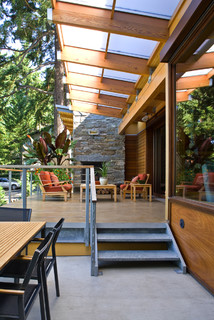In our energy efficiency series of articles featured each Thursday, we provide strategies or information on how to make your new home energy efficient and comfortable.
In modern and contemporary architecture it’s clear that glass is key. Full-height glazing, ribbon windows, tall windows, just about anything outside of traditional punched openings is the norm. But with larger expanses of glass it is often necessary — depending on window placement and orientation, among other things — to provide some sort of sunshade to cut down on solar heat gain in the warm months, while allowing light back in during fall and winter.
Nature provides the best sunshade: deciduous trees filter sunlight in the summer, but when their leaves fall of toward the winter, that valuable sunlight and heat is reintroduced into the house. But trees take time to grow, and sometimes it’s not possible to plant a tree in the place it’s needed for this type of shading. Enter louvered sunshades. These cantilevered assemblies filter the high summer sun, but their placement at the top of windows lets the low winter sun enter below them. Below is a sampling of some houses incorporating sunshades in various applications.
Each Thursday, we will feature a blog entry about energy efficient new homes, covering a range of topics from building innovations to ratings systems to “score” your home’s efficiency. Subscribe to the DrummondHousePlans blog to make sure you get the latest news on how to make your new or renovated home energy efficient.

